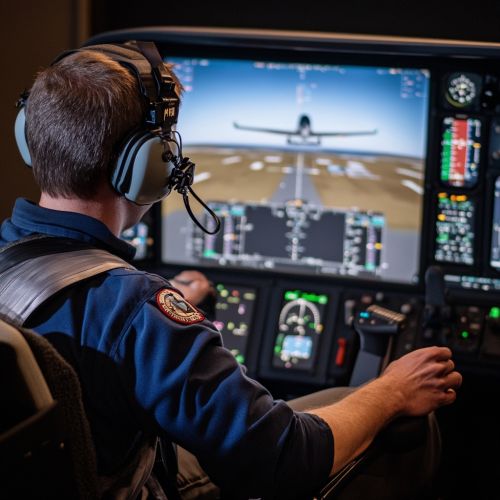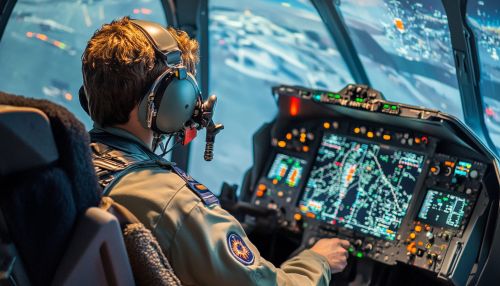Pilot Licensing: Difference between revisions
(Created page with "== Introduction == Pilot licensing is a regulatory process that ensures individuals who operate aircraft are qualified and competent to do so. This process involves rigorous training, testing, and certification to ensure the safety of both the pilot and the public. Pilot licenses are issued by aviation authorities in various countries and are categorized based on the type of aircraft and the level of responsibility the pilot will assume. == Types of Pilot Licenses == Pi...") |
No edit summary |
||
| Line 129: | Line 129: | ||
* [[Aerodynamics]] | * [[Aerodynamics]] | ||
[[Image:Detail-98115.jpg|thumb|center|An image of a pilot training in a flight simulator.|class=only_on_mobile]] | |||
[[Image:Detail-98116.jpg|thumb|center|An image of a pilot training in a flight simulator.|class=only_on_desktop]] | |||
== References == | == References == | ||
Latest revision as of 17:15, 25 September 2024
Introduction
Pilot licensing is a regulatory process that ensures individuals who operate aircraft are qualified and competent to do so. This process involves rigorous training, testing, and certification to ensure the safety of both the pilot and the public. Pilot licenses are issued by aviation authorities in various countries and are categorized based on the type of aircraft and the level of responsibility the pilot will assume.
Types of Pilot Licenses
Pilot licenses are categorized into several types, each with specific requirements and privileges. The most common types include:
Student Pilot License (SPL)
A Student Pilot License (SPL) is the initial step for aspiring pilots. It allows individuals to fly under the supervision of a certified flight instructor. The requirements for obtaining an SPL typically include a minimum age, medical certification, and successful completion of a written exam.
Private Pilot License (PPL)
A Private Pilot License (PPL) permits the holder to act as the pilot-in-command of an aircraft for non-commercial purposes. Requirements include a minimum number of flight hours, passing a written exam, and demonstrating flight proficiency. The PPL is often the foundation for further advanced certifications.
Commercial Pilot License (CPL)
A Commercial Pilot License (CPL) allows the holder to be compensated for their flying services. This license requires more extensive training and flight hours than a PPL, as well as successful completion of additional written and practical exams. CPL holders can work as pilots for charter flights, crop dusting, and other commercial operations.
Airline Transport Pilot License (ATPL)
The Airline Transport Pilot License (ATPL) is the highest level of pilot certification. It authorizes the holder to act as the pilot-in-command of commercial airliners. Requirements include a significant amount of flight experience, advanced theoretical knowledge, and passing rigorous exams. The ATPL is mandatory for captains of multi-crew aircraft.
Recreational Pilot License (RPL)
A Recreational Pilot License (RPL) is designed for individuals who wish to fly for leisure. It has fewer requirements than a PPL but also comes with more restrictions, such as limitations on the types of aircraft that can be flown and the distance from the home airport.
Sport Pilot License (SPL)
The Sport Pilot License (SPL) is tailored for flying light-sport aircraft. It requires fewer flight hours and less stringent medical certification compared to a PPL. This license is ideal for those who want to fly small aircraft for personal enjoyment.
Licensing Process
The process of obtaining a pilot license involves several steps, including medical certification, ground school, flight training, and examinations.
Medical Certification
Medical certification ensures that a pilot is physically and mentally fit to operate an aircraft. The requirements vary based on the type of license. For instance, an ATPL requires a Class 1 medical certificate, which involves comprehensive medical examinations, while a PPL may only require a Class 2 medical certificate.
Ground School
Ground school provides the theoretical knowledge necessary for flying. Topics covered include aerodynamics, meteorology, navigation, aircraft systems, and aviation regulations. Ground school can be completed through traditional classroom settings or online courses.
Flight Training
Flight training is conducted under the supervision of a certified flight instructor. It includes both dual instruction (with an instructor) and solo flights. Training covers various maneuvers, emergency procedures, cross-country navigation, and night flying, depending on the license sought.
Examinations
Pilots must pass both written and practical exams to obtain their license. The written exam tests theoretical knowledge, while the practical exam, also known as a check ride, assesses flight proficiency. The check ride is conducted by an examiner and includes both an oral component and a flight test.
Continuing Education and Recertification
Pilots are required to maintain their skills and knowledge through continuing education and periodic recertification. This ensures they remain competent and up-to-date with the latest aviation standards and regulations.
Currency Requirements
Currency requirements mandate that pilots must complete a certain number of flight hours and specific maneuvers within a given period to remain current. For example, to carry passengers, a pilot must have completed three takeoffs and landings within the preceding 90 days.
Recurrent Training
Recurrent training involves periodic training sessions to refresh and update a pilot's skills and knowledge. This can include simulator training, ground school, and flight training. Recurrent training is especially important for commercial pilots who operate complex aircraft.
Medical Recertification
Pilots must undergo periodic medical examinations to maintain their medical certification. The frequency and extent of these exams depend on the type of license and the pilot's age. For instance, a Class 1 medical certificate for an ATPL holder must be renewed annually for pilots under 40 and every six months for those over 40.
International Standards and Harmonization
Pilot licensing standards and regulations vary by country, but there are efforts to harmonize these standards internationally to facilitate the mutual recognition of licenses and ensure consistent safety levels.
International Civil Aviation Organization (ICAO)
The International Civil Aviation Organization (ICAO) sets global standards and recommended practices for pilot licensing. ICAO's Annex 1 outlines the requirements for personnel licensing, including medical standards, training, and examination procedures. Member states are encouraged to align their national regulations with ICAO standards.
Joint Aviation Authorities (JAA) and European Union Aviation Safety Agency (EASA)
In Europe, the Joint Aviation Authorities (JAA) and its successor, the European Union Aviation Safety Agency (EASA), have established common licensing standards for member states. EASA's regulations ensure that pilot licenses issued by one member state are recognized throughout the European Union.
Bilateral Agreements
Some countries have bilateral agreements that allow for the mutual recognition of pilot licenses. These agreements facilitate the transfer of licenses and enable pilots to operate in multiple jurisdictions without undergoing redundant certification processes.
Specialized Licenses and Endorsements
In addition to the primary pilot licenses, there are specialized licenses and endorsements that allow pilots to operate specific types of aircraft or perform particular operations.
Instrument Rating (IR)
An Instrument Rating (IR) allows a pilot to fly under Instrument Flight Rules (IFR), which is essential for flying in poor weather conditions and through controlled airspace. Obtaining an IR requires additional training and passing a written exam and practical test.
Multi-Engine Rating (MER)
A Multi-Engine Rating (MER) permits a pilot to operate aircraft with more than one engine. This rating involves specialized training to handle the complexities of multi-engine aircraft, including engine-out procedures and performance management.
Type Rating
A Type Rating is required to operate certain complex or large aircraft. Each type of aircraft that requires a Type Rating has specific training and examination requirements. Type Ratings are essential for pilots transitioning to different aircraft models, especially in commercial aviation.
Seaplane Rating
A Seaplane Rating allows a pilot to operate aircraft that can take off and land on water. This rating involves training in water operations, including docking, beaching, and handling rough water conditions.
Helicopter License
A Helicopter License is a separate category of pilot license that permits the holder to operate rotary-wing aircraft. The training and certification process for a helicopter license is distinct from that of fixed-wing aircraft and includes specialized maneuvers and emergency procedures.
Regulatory Authorities
Various regulatory authorities are responsible for overseeing pilot licensing and ensuring compliance with aviation standards.
Federal Aviation Administration (FAA)
In the United States, the Federal Aviation Administration (FAA) is the primary regulatory authority for pilot licensing. The FAA sets the standards for training, certification, and medical requirements, and conducts examinations and inspections to ensure compliance.
Civil Aviation Authority (CAA)
The Civil Aviation Authority (CAA) is the regulatory body in the United Kingdom. The CAA oversees pilot licensing, sets the standards for training and certification, and ensures that pilots meet the necessary medical and proficiency requirements.
Transport Canada Civil Aviation (TCCA)
Transport Canada Civil Aviation (TCCA) is responsible for pilot licensing in Canada. TCCA sets the standards for training, certification, and medical requirements, and conducts examinations and inspections to ensure compliance.
Other National Authorities
Each country has its own regulatory authority responsible for pilot licensing. These authorities set the standards for training, certification, and medical requirements, and ensure compliance with national and international aviation standards.
Challenges and Considerations
The process of obtaining and maintaining a pilot license involves several challenges and considerations.
Cost
The cost of pilot training and certification can be significant. This includes expenses for flight training, ground school, medical exams, and examination fees. Financial considerations are a major factor for many aspiring pilots.
Time Commitment
Obtaining a pilot license requires a substantial time commitment. This includes time spent in ground school, flight training, and studying for exams. Balancing training with other responsibilities can be challenging for many individuals.
Physical and Mental Fitness
Pilots must maintain a high level of physical and mental fitness. This includes meeting medical standards and managing stress and fatigue. Regular medical examinations and a healthy lifestyle are essential for maintaining fitness to fly.
Regulatory Changes
Aviation regulations are subject to change, and pilots must stay informed about new requirements and standards. This includes changes in medical certification, training requirements, and operational procedures.
Future Trends
The field of pilot licensing is evolving, with several trends shaping its future.
Technological Advancements
Advancements in technology are impacting pilot training and certification. This includes the use of flight simulators, online ground school, and digital resources for studying and exam preparation.
Unmanned Aerial Systems (UAS)
The rise of Unmanned Aerial Systems (UAS), also known as drones, is creating new opportunities and challenges for pilot licensing. Regulatory authorities are developing certification processes for UAS operators to ensure safe and responsible operation.
Global Harmonization
Efforts to harmonize pilot licensing standards globally are ongoing. This includes aligning national regulations with international standards and facilitating the mutual recognition of licenses. Global harmonization aims to enhance safety and efficiency in the aviation industry.
See Also


References
- International Civil Aviation Organization (ICAO) Annex 1 - Personnel Licensing
- Federal Aviation Administration (FAA) Pilot Certification
- European Union Aviation Safety Agency (EASA) Pilot Licensing Regulations
